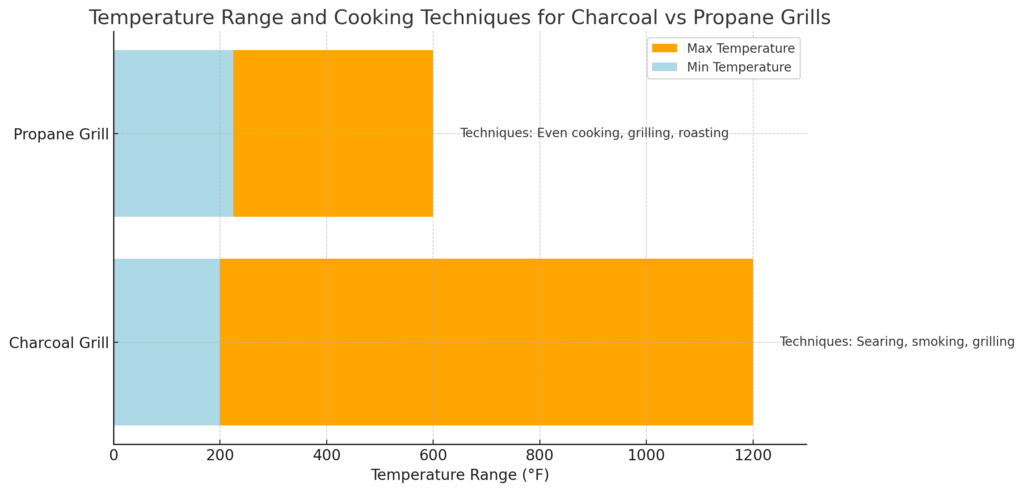Grilling enthusiasts often face a tough decision between charcoal and propane grills. Did you know over 60% of households use grills, and propane leads in popularity? Charcoal gives you that smoky flavor, but heating up takes time and effort. In contrast, propane grills are fast and easy, making weeknight grilling a breeze. They reach cooking temperatures in minutes.
But here’s the catch. Charcoal lovers swear by the deep, smoky taste, while propane fans enjoy precise temperature control. Each grill has pros and cons, and I’m here to help you pick the one that fits your lifestyle. Keep reading, and let’s find your perfect grill!
Keynote: Charcoal Grill vs Propane Grill
Charcoal grills offer rich, smoky flavor and high-heat searing but take longer to prepare. Propane grills provide quick, convenient cooking with easier temperature control. Your choice depends on whether you prioritize flavor or convenience. Both have unique strengths, so it comes down to personal preferences and grilling needs.
Flavor Profile: How Does Each Grill Affect Flavor?
Charcoal grilling gives food a smoky, rich flavor. This happens as the charcoal burns, releasing organic compounds that infuse the food with deep, charred taste. It’s perfect for steaks, ribs, and any food that benefits from that bold, fire-kissed flavor.
Propane grills, on the other hand, produce a cleaner flame. The focus here is on the food’s natural taste without adding much flavor from the flame. This makes propane grills great for more delicate foods like fish, vegetables, and even fruits.
Here’s a quick comparison:
| Grill Type | Flavor Intensity | Best For |
|---|---|---|
| Charcoal Grill | Smoky, rich, charred flavor | Steaks, ribs, burgers, and meats requiring deep flavor |
| Propane Grill | Clean, natural food taste | Fish, vegetables, fruits, and delicate foods |
Temperature Control and Heat Output: Which Grill Provides Better Control?
Charcoal grills can reach extremely high temperatures, up to 1200°F. This makes them perfect for high-heat searing or slow smoking. However, controlling the heat isn’t as simple. You need to adjust air vents and charcoal placement to manage the temperature, which takes practice.
Propane grills are much easier when it comes to temperature control. With just a turn of the dial, you can adjust the heat, usually ranging between 225°F and 600°F. This makes them perfect for consistent and even cooking without the hassle of managing airflow or fuel.
Here’s a chart highlighting the temperature ranges and cooking techniques for each type:

This chart shows how each grill type excels in different cooking methods, helping you choose based on your grilling style!
Convenience and Ease of Use: Which Grill is More Convenient for Everyday Use?
Propane Grills:
Pros:
- Quick ignition with the push of a button.
- Ready to cook in under 10 minutes.
- Minimal setup and easy to control the temperature.
- Simple and faster cleanup since there’s no ash.
- Great for quick weeknight meals or when you’re short on time.
Cons:
- Requires propane tank refills.
- Limited to a lower maximum temperature compared to charcoal.
Charcoal Grills:
Pros:
- Adds a rich, smoky flavor that propane can’t match.
- Better for high-heat grilling and slow smoking.
- Ideal for weekend barbecues when you have more time.
Cons:
- Takes 15–20 minutes to heat up.
- More effort required to light and manage the coals.
- Longer cleanup due to ash and debris.
- Requires constant monitoring for temperature adjustments.
Cost and Fuel Efficiency: Which is More Affordable?
Regarding cost, there are noticeable differences between charcoal and propane grills. Let’s break it down:
Initial Costs:
- Charcoal Grills: Typically cheaper, with prices ranging from $15 to $150 depending on the model and size.
- Propane Grills: Usually cost more upfront, ranging between $130 and $300 for a basic unit.
Fuel Efficiency:
- Charcoal Grills: Less fuel-efficient. Each grilling session costs around $3.30 in charcoal.
- Propane Grills: More fuel-efficient, with a $15 propane tank lasting up to 25 sessions, bringing the cost to about $0.60 per session.
| Category | Charcoal Grill | Propane Grill |
|---|---|---|
| Initial Cost | $15 to $150 | $130 to $300 |
| Fuel Cost per Session | $3.30 per session | $0.60 per session |
| Fuel Efficiency | 1 session per refill | Up to 25 sessions per propane tank |
| Maintenance & Accessories | Moderate (frequent cleaning, ash removal) | Low (minimal cleaning, propane refill) |
This table outlines the key cost factors, making it easy to compare which grill suits your budget and usage needs.
Environmental Impact: Which Grill is More Eco-Friendly?
When it comes to the environment, the differences between charcoal and propane grills are clear.
Charcoal grilling releases approximately 11 pounds of CO₂ per hour of use. The smoke from burning charcoal also contributes to air pollution, and the leftover ash must be disposed of properly. Charcoal is often made from wood, and its production can contribute to deforestation.
Propane grills are a cleaner option, emitting only 5.6 pounds of CO₂ per hour, nearly half that of charcoal. Additionally, they produce no ash, making them much more eco-friendly for regular grilling. Propane is a fossil fuel, but its cleaner burn reduces environmental impact compared to charcoal.
Here’s a quick comparison of the environmental impact:
| Grill Type | CO₂ Emissions per Hour | Waste Produced | Environmental Concerns |
|---|---|---|---|
| Charcoal Grill | 11 pounds of CO₂ | Ash and air pollution | Deforestation, higher emissions |
| Propane Grill | 5.6 pounds of CO₂ | Minimal ash or residue | Lower emissions, fossil fuel use |
Versatility and Cooking Techniques: Which Grill is More Versatile?
Charcoal grills excel at high-heat cooking techniques like searing and smoking. The open flame offers flexibility in temperature control, making them great for slow cooking, roasting, and creating that signature smoky flavor.
Propane grills are ideal for everyday grilling and work best with foods that require consistent, even heat. Many propane models come with added features like side burners, offering more flexibility for multitasking while grilling.
Here’s a side-by-side comparison of each grill’s performance across different cooking methods:
| Cooking Method | Charcoal Grill | Propane Grill |
|---|---|---|
| Searing | Excellent (High Heat) | Good (Less High Heat) |
| Smoking | Best Option (Low Heat) | Not Ideal (Requires Extra Equipment) |
| Roasting | Good (Vents for Heat Control) | Excellent (Precise Control) |
| Grilling | Great (Smoky Flavor) | Great (Even Cooking) |
| Slow Cooking | Ideal (Control with Charcoal Placement) | Good (Consistent Temperature) |
Cleaning and Maintenance: Which Grill is Easier to Clean?
Cleaning a charcoal grill can be a bit of a chore. After every use, you’ll need to empty the ashes and clean the grates, which can get messy with soot and grease buildup. Here’s a quick cleaning guide for charcoal grills:
Charcoal Grill Cleaning Guide:
- Wait for Ashes to Cool: Let the coals completely cool before cleaning to avoid fire hazards.
- Empty the Ashes: Remove the ash catcher or tray, then dump the cooled ash into a metal container.
- Scrub the Grates: Use a wire brush to scrub off any food remnants and grease from the grates.
- Clean the Inside: Use a damp cloth or mild soapy water to wipe down the interior of the grill.
- Vent and Lid Maintenance: Check and clean the vents regularly to ensure airflow, and scrub any build-up on the lid.
Propane grills are easier to clean because they produce less residue. Without ash, all you need to focus on are the grates and burners. Here’s a quick cleaning guide for propane grills:
Propane Grill Cleaning Guide:
- Preheat and Scrape: After cooking, preheat the grill for a few minutes to burn off excess food. Use a grill brush to scrape the grates while still warm.
- Clean the Burners: Turn off the gas and remove the grates to clean the burners using a soft brush.
- Empty the Drip Tray: Remove and empty the grease tray, wiping it clean with warm, soapy water.
- Wipe Down the Exterior: Use a damp cloth to clean the outside of the grill, keeping it looking new.
- Regular Deep Cleaning: Every few months, disassemble the grill (following the manual) and give it a thorough clean.
Final Thoughts
The choice between a charcoal grill and a propane grill comes down to your personal priorities. Do you value the rich, smoky flavor that only charcoal can provide, or is the convenience and precision of propane more appealing for your everyday grilling needs? Both offer unique benefits that cater to different cooking styles and preferences.
Think about how you want your grilling experience to feel. Is it a slow, leisurely event with time to build the perfect fire, or a quick and efficient process to get food on the table? Your decision will shape more than just what you eat—it will define how you savor the experience.
Charcoal vs Propane Grill (FAQs)
What is better, a propane or a charcoal grill?
A propane grill offers convenience, quick ignition, and precise temperature control. A charcoal grill provides smoky flavors and high-heat searing. The best choice depends on whether you prioritize ease or flavor.
Is propane healthier than charcoal grill?
Yes, propane is generally considered healthier because it produces fewer carcinogens compared to charcoal grilling. Charcoal grilling releases more harmful chemicals due to smoke and flare-ups.
What’s the difference between charcoal and gas grills?
Charcoal grills offer a smoky flavor and require more time and effort to control the heat. Gas grills provide quicker heat-up times, easier temperature control, and cleaner cooking with less smoke.
Is a charcoal or gas grill better for steak?
Charcoal grills are better for steak due to their ability to reach higher temperatures for perfect searing. Gas grills are more convenient but may not achieve the same smoky, charred flavor.
Are gas-and-charcoal combo grills worth it?
Combo grills are worth it if you enjoy the flexibility of both fuel types. They offer the convenience of propane and the rich flavor of charcoal, but they require more space and maintenance.
Is propane better than natural gas for grilling?
Propane provides more portability and higher energy efficiency per unit. However, natural gas is more cost-effective if you have a permanent grilling setup. Both are cleaner-burning than charcoal.
What’s the best way to sear a burger on a charcoal grill?
Using direct heat over hot coals is the best way to sear a burger. Charcoal grills provide high heat for perfect searing.
Why use a chimney starter with charcoal briquettes?
A chimney starter lights charcoal briquettes without lighter fluid, creating a cleaner burn and avoiding unwanted chemicals.
How does indirect heat benefit cooking time for larger meats?
Indirect heat allows longer cooking time without burning food. It’s ideal for roasting or smoking meats like bacon using a smoker.
What’s the difference between cooking with propane and charcoal fire?
Propane offers less time to heat up and control with a knob. Charcoal fire gives a better flavor through smoke flavor and radiant heat.
Can you use a smoke box on a Weber gas grill for wood chips?
Yes, adding a smoke box with wood chips to a Weber gas grill enhances smoke flavor, simulating charcoal grilling for a great deal of versatility.
How does the surface area of cooking grates impact grilling?
Larger surface areas on cooking grates allow grilling more food, from hot dogs to veggies, efficiently using either charcoal or an average gas grill.

Katie Lee has over 20 years of experience in the kitchen. She helps homeowners find the right appliances for their needs to sets up a perfect kitchen system. She also shares helpful tips and tricks for optimizing appliance performance.

